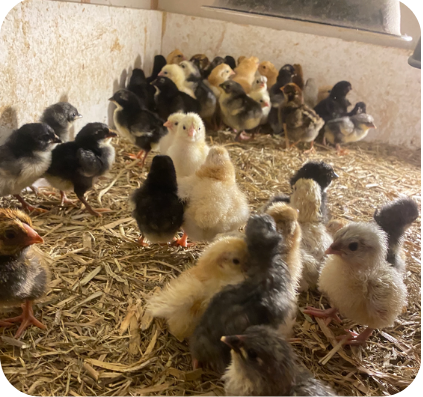Are Mixed Breeds Better Than Purebred Dogs?

Published
29 Aug 2023Estimated Time
Purchasing a pup isn’t a decision to make lightly.
Hi, I’m Hayden Challoner, and I’m the Founder and Director of YouChoose Pets and Livestock. I have over 20 years of experience in breeding and raising a range of different animals.
Not counting being raised in a household where my mother and father also bred a range of animals from ostriches to guinea pigs.
Some of my fondest memories as a kid were waking up in the morning eager to see if new baby animals had been born overnight and to be honest, that’s never changed.

A common dilemma I see in the market today for people looking to buy a pet is whether they should go for mixed breeds or purebreds.
Purchasing a dog is a VERY exciting time. Particularly for families with children.
The bond that is created between a family and a dog is something very special. It creates ever-lasting memories for all.
You want to make the best decision possible for you and your family.
YouChoose Pets and Livestock focuses on empowering buyers to make the best decision possible when buying a pet and offers informative knowledge on buying and selling pets and livestock.
Join Our Mailing List
Stay connected with us for regular updates from us 1-2 times per month, packed with valuable insights and tips like the YouChoose Animal showcase and trialled and tested best practices for raising your animals.

"*" indicates required fields
By signing up you are agreeing to our Terms of Service and Privacy Policy
For now let’s look at some popular topics and research on the old-age debate of mixed breeds versus purebreds.
And some of the most commonly asked questions YouChoose animal sale experts receive on purebreds and mixed breeds.

What Is the Difference Between Purebreds, Crossbreeds and Mixed Breeds?
Purebreds refer to dogs only from one specific breed. The current industry standard for an animal to be considered purebred is that the percentage of full blood genetics needs to be above 87.5%.
Whereas a mixed breed is a minimum of three different dog breeds. A dog of no definitive lineage. Their ancestry is usually complex or unknown.
Then there are crossbreeds.
Generally, crossbreeds have a known lineage and are from two distinct purebred parents.
There are varying definitions between mixed breeds and crossbreeds. If you do a simple Google search on mixed breeds it says a dog with two or more different breeds in its lineage. Most research defines mix breeds as a breed of three or more.
For now, we’ll compare mixed breeds with a combination of three or more breeds.
Crossbreeds are briefly considered. With a comparison of a purebred Yorkshire Terrier and a Yorkshire Terrier mix. Other than that this article focuses on mixed breeds and purebreds.

Are Mixed Breed Better Than Purebred Dogs?
This is a heavily contented and popular question, especially among dog enthusiasts. Wouldn’t it be easy if it was a simple yes or no?
It isn’t.
It is a matter of perspective and what you are looking for in a dog.
Usually, the market for sheltered dogs, mixed breeds and purebreds are entirely different customers. People in the market for a purebred will have specific objectives that often mix breeds and sheltered dogs don’t meet.
For instance, Guide Dogs Australia has a specific need for purebred golden retrievers. Purebred German shepherds are golden standards dogs for police work. Purebred poodles are popular therapy dog options.
But what if you want a purebred as a pet, not as a working dog?
Lots of people prefer purebreds over mixed breeds for a number of reasons. This could be personal preference, yard size restrictions, allergic reactions, a childhood connection and kinship. Like that Golden Retriever, Buddy, you used to play fetch and cuddle with as a kid.
No matter the reasons if you’re considering a mixed breed or a purebred we encourage you to first consider your personal, lifestyle and family needs.
Here are some questions to consider when determining what breed of dog to purchase for your family.
- How much exercise can you commit to per day?
- Can you deal with an unexpected vet bill and recurring grooming costs?
- What level of time can you commit to connection and play each day?
- If you have kids, what breeds are best for younger versus older kids?
- What home improvements need to be made to suit having a dog?
- Does the dog need yard space? If yes, do you have enough space?
Always start with your personal, lifestyle and family needs then work your way back to breeds that fit into these needs. Then consider the dog’s health and behaviour characteristics.
One thing is certain – if you make the wrong decision and purchase a breed that doesn’t suit your existing home environment and lifestyle needs, it can cause much distress for you and the dog
One of the most common reasons dogs end up in shelters other than being found on the street is because the owners give up on them.
Let’s look at a specific example that considers your personal, lifestyle and family needs and deciding on a breed that fits these needs.

Yorkshire Terrier Purebred Compared With Yorkie Poo
Let’s consider the difference between a Yorkshire Terrier purebred with a Yorkie Poo – A Yorkshire Terrier cross poodle. Often referred to as a designer dog.
An entire article can be dedicated to comparing these two breeds. For now, this is a brief comparison of a few behavioural characteristics to give you an idea of how to match up a breed with your specific needs.
Yorkshire purebreds are known to be energetic, feisty, sensitive, and affectionate. They are good apartment dogs and are loyal to their owners. However, being sensitive means they can be feisty.
Snappy, impatient behaviour is common in Yorkshires. This makes them unsuited for families with younger children. Older children, like young teens and upwards will suit fine.
Yorkie Poos, on the other hand, have a slightly different temperament. The difference comes with the influence of Poodle genetics.
They are less stubborn, more open and are known to be smarter than the purebred Yorkies. If properly socialised at a young age, they can be fine with younger children.
We recommend also chatting with your breeder about any specific needs and concerns before making a purchase.

Are Mixed Breed Dogs Healthier Than Purebred Dogs?
The answer to this question is not straightforward either. There is no hard and fast rule here.
There are a lot of variables. Like body mass and existing issues with the DNA, the dog contains. Also, external environmental factors have an impact. Such as
- How often the dog is exercised?
- Has the dog been trained?
- How much experience the owner has with dogs?
You might be only concerned with physical health. Ceaser Milan’s (2022)1 rule of thumb is that mixed midsized pups on average are the healthiest dog. Their high genetic mix means they are less likely to have the genetic problems purebreds are known to have.
Nevertheless, there are 300-400 different types of mixed breeds worldwide. In Australia alone, there are around 3 million mixed breed dogs.
To complete a definitive scientific study is complex and costly.
But you’re in luck!
Science has some qualified advice backed by research about the health of purebreds compared to mixed breeds.
YouChoose Pets and Livestock sales expert team has over 60 years of experience combined in rearing and raising dogs. We recommend taking a holistic approach when choosing a pet. Physical health should be considered equally with mental health and behavioural traits.
Take this research with a grain of salt. Using your Instinct and being a real on what dog breed best suits your needs is equally if not more effective with making a good choice.

Longevity of Purebreds Compared to Mix Breeds
Mixed breed dogs, on average, do live longer than purebred dogs (Turcsán et al., 2017)2. Not by much. A study done in Japan found on average mixed breeds lived 1.3 years longer than purebred.
This study also showed other factors influencing lifespan. Regardless of being purebred or mixed breed. It revealed female dogs live longer than male dogs if they are desexed.
Cancer Differences: Purebreds Compared to Mix Breeds
Cancer is the next biggest cause of death in pet dogs after old age. I have had several pet dogs die of cancer. There have been many scientific studies done on the risk of cancer in mixed breeds compared to purebreds – the outcomes differed considerably.
Results varied depending on the type of cancer, sex, body mass and more. Here are some of the results from studies around the world.
- Purebreds have a 2-5% high risk of dying of cancer-related causes compared with mixed breed dogs (Proschowsky et al. 2003)3
- Bernese mountain dogs, golden retrievers and beagles have approx 33% risk of dying of cancer-related causes
- Female dogs have up to double the risk of dying from tumours compared with male dogs across all breeds (Bonnett et al. 2005)4
- Male mixed breed dogs and male purebred dogs have more or less the same risk of testicular cancer (Nodtvedt et al. 2011)5
All good points to consider.
Behaviour Differences: Purebreds Compared to Mix Breeds
Studies have shown a big difference in behavioural traits between mixed breeds and purebreds.
Bennett and Rholf (2007)6 found mixed breeds to be more disobedient than purebreds. Meaning the extent the dogs fail to sit, stay or come when called and, how often the dog soils in the house.
Overall, mixed breeds had less manners compared to purebreds. This can be minimised with a commitment to consistent dog training.
Mixed Breeds More Prone to Accidents Than Purebreds
Misbehaving dogs are more prone to causing road accidents, property damage and injury to themselves and others.
Kristensen and Elfwing (2020)7 found in their studies, accidents in mixed breeds were more common on average compared to purebreds. Accidents like fractured limbs and road incidents.
Mix breeds have a high chance of death caused by accidents like these.

So What Breed Are You Going to Choose for Your Next Pet Dog?
As you can see there is a lot to answering the question are mixed breeds better than purebreds?
Being clear on what a mixed breed, purebred and crossbreed, is a good starting point. Particularly, if you are brand new to the market.
YouChoose Pets and Livestock has a range of different sellers offering both mixed breeds and purebreds. Within the animal’s profile, sellers can upload information about the animal’s lineage into the Visual Lineage Archive (VLA).
The VLA is a unique feature of the YouChoose Pets and Livestock app.
There is nothing like it in the world to date. It visually displays the animal’s lineage. Sellers can constantly add to it. Making it an ever-evolving feature. It provides an effective way of recording multiple animals’ lineage all in one place.
Buyers now have an accessible visual of their animals’ lineage. You can follow your dog’s breeder and keep up to date with your dog’s family tree.
Learn more about the VLA Feature.
The current research on comparing physical health issues and traits between mixed breeds and purebreds is much the same. It’s hard to make a decision entirely on physical health differences alone. The behavioural differences are a standout though and something to consider.
Start with your personal, lifestyle and family needs. Then work your way back to breeds that fit those needs. Also, have a chat with your breeder about any queries and concerns and do not underestimate the power you can have on the outcomes of your dog. I often say to buyers that you get back out of a dog what you put in. Like your time, attention and discipline pay off over time.
You can always connect with a YouChoose animal sales expert too at hello@youchoose.com.au
A dog companion is a fulfilling part of life.
We wish you the best of luck with your new pet purchase.
The YouChoose Pets and Livestock Team.
Citations:
- How to Pick a Healthy Puppy | Healthy Dog Breeds. (2022, April 5). Cesar’s Way. https://www.cesarsway.com/how-to-pick-a-healthy-pup/
- Turcsán, B., Miklósi, Á., & Kubinyi, E. (2017). Owner perceived differences between mixed-breed and purebred dogs. PLOS ONE, 12(2), e0172720. https://doi.org/10.1371/journal.pone.0172720
- Proschowsky, H. F., Rugbjerg, H., & Ersbøll, A. K. (2003). Mortality of purebred and mixed-breed dogs in Denmark. Preventive Veterinary Medicine, 58(1-2), 63–74. https://doi.org/10.1016/s0167-5877(03)00010-2
- Bonnett, B. N., Egenvall, A., Öhagen, P., Olson, P., Hedhammar, Å., & Euler, H. von. (2005). Incidence of and survival after mammary tumours in a population of over 80,000 insured female dogs in Sweden from 1995 to 2002. Preventive Veterinary Medicine, 69(1-2), 109–127. https://doi.org/10.1016/j.prevetmed.2005.01.014
- Nødtvedt, A., Gamlem, H., Gunnes, G., Grotmol, T., Indrebø, A., & Moe, L. (2010). Breed differences in the proportional morbidity of testicular tumours and distribution of histopathologic types in a population-based canine cancer registry. Veterinary and Comparative Oncology, 9(1), 45–54. https://doi.org/10.1111/j.1476-5829.2010.00231.x
- Bennett, P. C., & Rohlf, V. I. (2007). Owner-companion dog interactions: Relationships between demographic variables, potentially problematic behaviours, training engagement and shared activities. Applied Animal Behaviour Science, 102(1-2), 65–84. https://doi.org/10.1016/j.applanim.2006.03.009
- Kristensen, S. F. (2020). Are mixed-breed dogs healthier than purebred dogs? A review of the current data on diseases and longevity in dogs. (Dissertation). Retrieved from http://urn.kb.se/resolve?urn=urn:nbn:se:lnu:diva-96779



